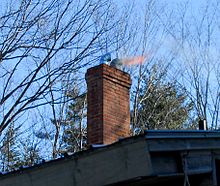Chimney fire
A chimney fire is the combustion of residue deposits referred to as creosote, on the inner surfaces of chimney tiles, flue liners, stove pipes, etc. The process begins with the incomplete combustion (burning) of fuel in the attached appliance, usually a wood or coal stove. The unburned volatiles are heated to the vapor state but not consumed due to a lack of adequate heat and oxygen within the appliance. These volatile distillates escape into the chimney, where they contact cooler surfaces and condense into tar-like deposits. Successive layers accumulate until either the chimney plugs completely, or the chimney reaches a temperature and oxygen level at which the deposit will ignite. Due to the concentrated level of volatile material now present, these fires tend to burn very hot.[1] The high temperatures stress the mechanical strength of the chimney causing distortion of metal structures, and failure of ceramic structures.
Causes of the deposits which lead to chimney fires include using green/wet fuels, the operation of appliances with insufficient air intake, and low operating temperatures for prolonged periods followed by hot fires. Such practice typically occurs when mild weather periods are followed by cold snaps.
Steps to avoid this buildup of deposits include running appliances hot during initial ignition phase regularly, building short hotter fires, regular cleaning of flues, and using interior chimney structures where possible versus chimneys attached to exterior walls. The latter tend to be cooler contributing to the problem as well as creating downdrafts which tend to introduce smoke into the structure as the fire subsides.
Control includes denial of oxygen, addition of extinguishing agents, and removing heat sources. Local fire authorities should be immediately notified due to the danger of failure of the chimney to maintain integrity, and spread of fire within adjoining partitions of the structure. Additional hazards include the possible buildup of toxic gases such as carbon monoxide[2] within the structure due to restricted flues.
